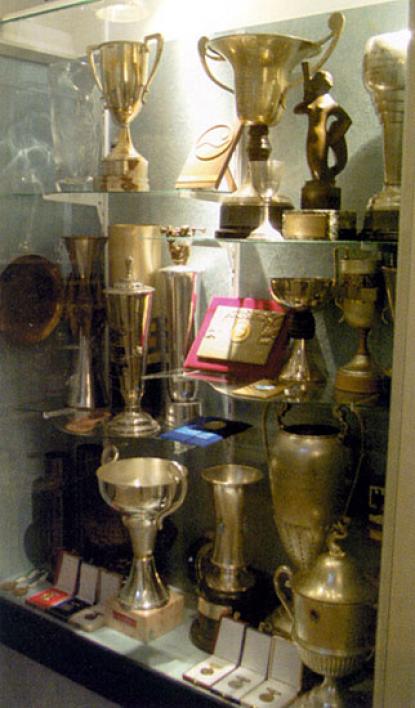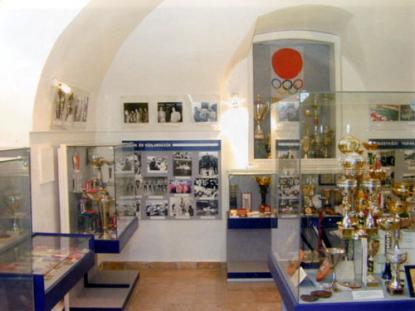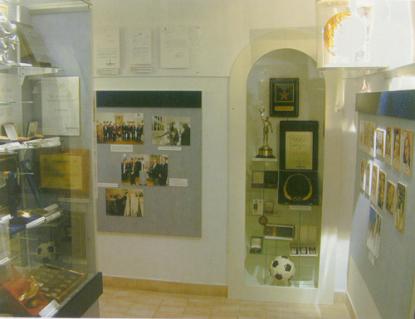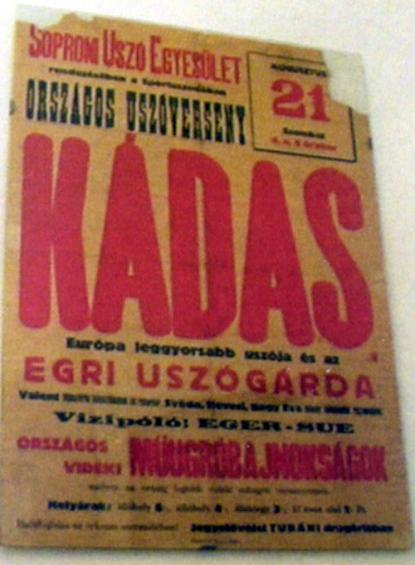2024. April 25. Thursday
Heves County Sports Museum - Eger

|
Address: 3300, Eger Kossuth Lajos utca 9.
Phone number: (20) 545-5050
E-mail: diamond.ring@axelero.hu
Opening hours: 01.05-30.09.: Tue-Sun 9-17
|
The historic past of Eger, the beauty and the high quality wines of this baroque town, and last but not least the fortress of Eger with the heroism of the gallant soldiers of the borders attract tourists from all parts of the world. The natural hot springs these natural resources also constitute the treasure of Eger. Tourists who have a desire for a bath can enjoy not only the refreshing warm water but its curing effects, as well, if taking advantage of the water they visit the open-air bath or the swimming pool.
In 1828 László Gorové wrote the following lines about the origin of these hot springs: "Outside of the town, to the East those warm thermal baths are to be found that were much liked by the Turkish. Above all, the water is not at all as hot as the springs in the Buda Hills. Some of the walls and doors of the bathhouses reflect the old Gothic style, thus it follows that they were used long before the Turkish conquest." There were, and still are, scientists and writers who "originate the name of "Heves county" from this spring." - and based on a good reason, too, for from the name of the spring "heves" the name of the county can be deduced also.Basically these are those springs that have made it possible throughout the years for swimming and water polo to be developed as a sport.
The facilities provided by hot springs and the beginning of the operation of the institution serving as the cradle of swimming sports can be traced back to the 1880s. At that time, however, swimming was not considered to be a competitive sport, in spite of the fact that the first sports club, The Gymnastic Club of Eger ('ETE') was founded in 1873. Thus possibilities for expansion were founded and the first swimming competition was held in 1913, in which only swimmers from the county were allowed to participate. Following this event, 1916 was the year when, along with the participation of contestants from the capital city, the first official swimming competition took place.
Competitive sport was developed, which became world-famous first in terms of swimming and then of water-polo. In the April of 1925, during the tour of the club in Germany, due to the swimmers' successful contest against the swimmers of Magdeburg, the German sports magazine "Der Schwimmer" named Eger "the citadel of Hungarian swimming sport" and "the Hungarian Magdeburg." A year later, after the swimmers of Magdeburg suffered defeat in Eger, the German magazine wrote the following lines in desperation: "We would like to be able to call Magdeburg the German Eger." This statement is still valid today, as shown by the statement of the President of the Hungarian Republic, Árpád Göncz, upon visiting the Sports Museum of Eger and signing its visitors' book, even if he used different words: "Without Eger, the history of Hungarian sport, especially that of swimming, is unimaginable."
The internationally well-known sports history of this one thousand year-old city fits well into its present. The immortaliser of the more than a hundred years old sporting past is the Sports Museum, which is to be found in the nearly 250 year old County Prison building, in the yard of the County Hall. The historical building guards historical sports history. We arrive through posters and certificates representing Olympics on the access corridor at 'A', reception hall, where prizes of the most successful team achievements can be seen. In the middle of the room Olympic medals and participation badges of Sportsmen and Sportswomen from Heves County represent the successes gained at the Olympic Games from the first one held in Athens in 1856 until the last games in Sydney in 2000. Connected to this hall there is another one collecting the awards representing the international successes of the Hungarian swimming and water polo team.
The Sports museum erects a monument to Dr. István Bárány in a special way. Fulfilling his will, after his death his ashes were buried in an urn into the walls of the museum thus providing a final resting place for this excellent sportsman, citizen and honorary freeman of the city.
The park of the participants of the Olympic Games has already immortalised the name of 93 participants and 174 events at the Olympic Games. It has revealed all those participants for the history of sports who were born in Heves county or used to be trained here or have taken part in the Olympics as trainers or sport-leaders. In such a form, with the statue of Dr. Ferenc Kemény, there is not any other monument in Hungary in memory of the participants of the Olympic Games.
Dr. Ferenc Székely
In 1828 László Gorové wrote the following lines about the origin of these hot springs: "Outside of the town, to the East those warm thermal baths are to be found that were much liked by the Turkish. Above all, the water is not at all as hot as the springs in the Buda Hills. Some of the walls and doors of the bathhouses reflect the old Gothic style, thus it follows that they were used long before the Turkish conquest." There were, and still are, scientists and writers who "originate the name of "Heves county" from this spring." - and based on a good reason, too, for from the name of the spring "heves" the name of the county can be deduced also.Basically these are those springs that have made it possible throughout the years for swimming and water polo to be developed as a sport.
The facilities provided by hot springs and the beginning of the operation of the institution serving as the cradle of swimming sports can be traced back to the 1880s. At that time, however, swimming was not considered to be a competitive sport, in spite of the fact that the first sports club, The Gymnastic Club of Eger ('ETE') was founded in 1873. Thus possibilities for expansion were founded and the first swimming competition was held in 1913, in which only swimmers from the county were allowed to participate. Following this event, 1916 was the year when, along with the participation of contestants from the capital city, the first official swimming competition took place.
Competitive sport was developed, which became world-famous first in terms of swimming and then of water-polo. In the April of 1925, during the tour of the club in Germany, due to the swimmers' successful contest against the swimmers of Magdeburg, the German sports magazine "Der Schwimmer" named Eger "the citadel of Hungarian swimming sport" and "the Hungarian Magdeburg." A year later, after the swimmers of Magdeburg suffered defeat in Eger, the German magazine wrote the following lines in desperation: "We would like to be able to call Magdeburg the German Eger." This statement is still valid today, as shown by the statement of the President of the Hungarian Republic, Árpád Göncz, upon visiting the Sports Museum of Eger and signing its visitors' book, even if he used different words: "Without Eger, the history of Hungarian sport, especially that of swimming, is unimaginable."
The internationally well-known sports history of this one thousand year-old city fits well into its present. The immortaliser of the more than a hundred years old sporting past is the Sports Museum, which is to be found in the nearly 250 year old County Prison building, in the yard of the County Hall. The historical building guards historical sports history. We arrive through posters and certificates representing Olympics on the access corridor at 'A', reception hall, where prizes of the most successful team achievements can be seen. In the middle of the room Olympic medals and participation badges of Sportsmen and Sportswomen from Heves County represent the successes gained at the Olympic Games from the first one held in Athens in 1856 until the last games in Sydney in 2000. Connected to this hall there is another one collecting the awards representing the international successes of the Hungarian swimming and water polo team.
The Sports museum erects a monument to Dr. István Bárány in a special way. Fulfilling his will, after his death his ashes were buried in an urn into the walls of the museum thus providing a final resting place for this excellent sportsman, citizen and honorary freeman of the city.
The park of the participants of the Olympic Games has already immortalised the name of 93 participants and 174 events at the Olympic Games. It has revealed all those participants for the history of sports who were born in Heves county or used to be trained here or have taken part in the Olympics as trainers or sport-leaders. In such a form, with the statue of Dr. Ferenc Kemény, there is not any other monument in Hungary in memory of the participants of the Olympic Games.
Dr. Ferenc Székely



